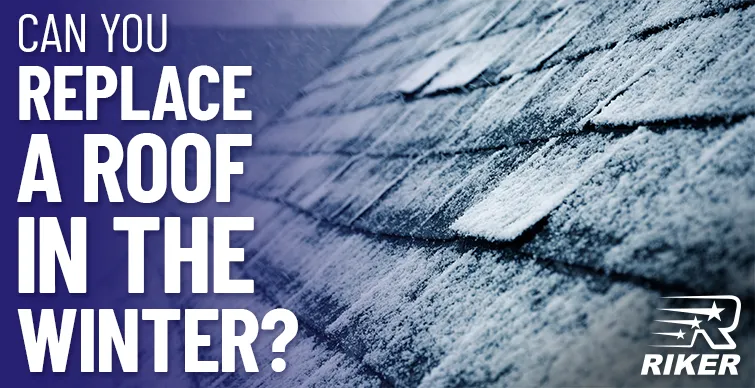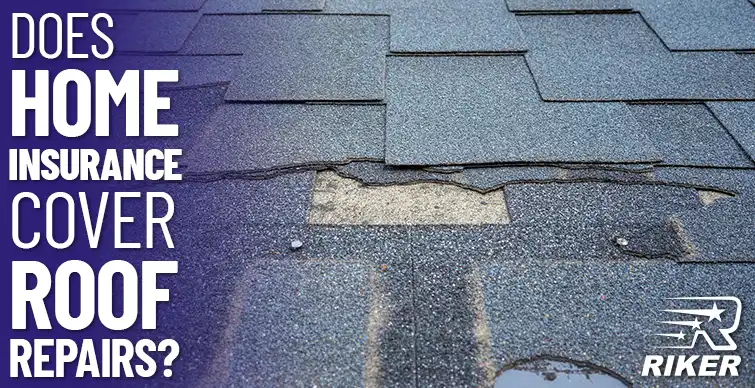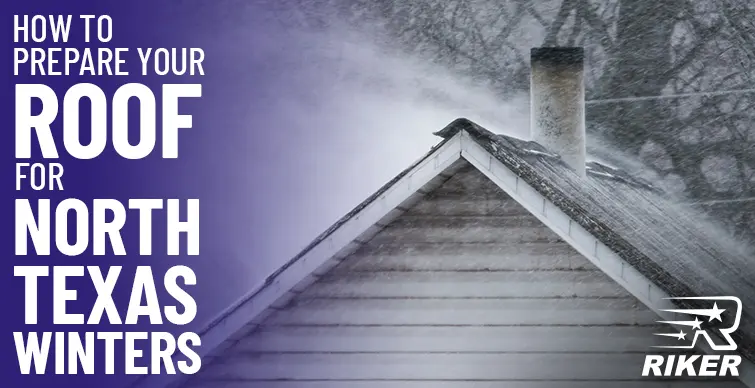Severe hailstorms can cause significant damage to your roof, often in ways that aren’t immediately noticeable. Understanding what hail damage looks like on a roof can make all the difference—it can save you from turning a simple roof repair into a major, costly renovation. By learning how to identify and address hail damage, you’ll be able to recognize the signs of damage, assess the severity of the impact, and take the necessary steps to prevent further damage and costly repairs.
How Does Hail Damage My Roof?
Hail damage occurs when hailstones, formed by thunderstorms, impact and strike your roof. Even moderate hailstorms can wreak havoc, causing functional damage and weakening your roof’s protective surface.
Hailstone size is a major factor in the severity of roof damage. Pea-sized hail may just scatter lightweight granules from asphalt shingles. However, hailstones 1 inch wide or larger can puncture shingles, crack tiles, and leave indentations that create entry points for moisture intrusion over time.
The larger and denser the hailstone, the more force it carries when striking. Hailstones over 2 inches can fall at speeds up to 100+ mph, acting like natural battering rams that can severely compromise roofing materials upon impact. This leads to leaks, granule loss, and accelerated roof deterioration if not promptly repaired or replaced after a major hailstorm.
What Does Hail Damage Look Like on a Roof?
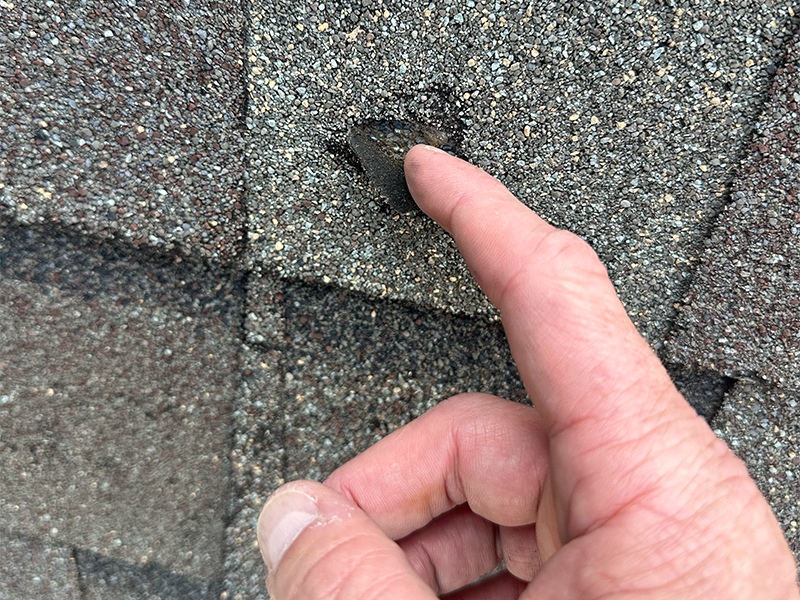
The severity of hail damage on a roof varies with the size and impact force of the hailstones. First, let’s cover the common signs of hail damage, and then we’ll dive into how different sizes of hail can affect your roof.
Common Signs of Hail Damage to Your Roof
- Shingles on the ground: After a hailstorm, inspect your property for dislodged shingles.
- Dents in metal components: Inspect the metal flashing and vents. Dents here are clear indicators of hail impact.
- Granule loss: Hail can cause granules to be knocked off of asphalt shingles, leading to exposed and damaged areas.
- Damaged roof features: Check skylights, chimneys, and vent caps for signs of hail damage such as cracks or breaks.
- Sagging ceiling: Hail can cause water to collect in the attic, leading to a sagging ceiling.
- Water stains: Hail can cause water stains on ceilings and walls, which can be a sign of a leak.
- Fiberglass mat damage: Hail can cause the surfacing of shingles to break away, exposing the fiberglass mat underneath, and/or cause fractures in the fiberglass mat, leading to tears and cracks.
Hail Damage by Size
Hailstones smaller than 1 inch (2.5 cm) in diameter:
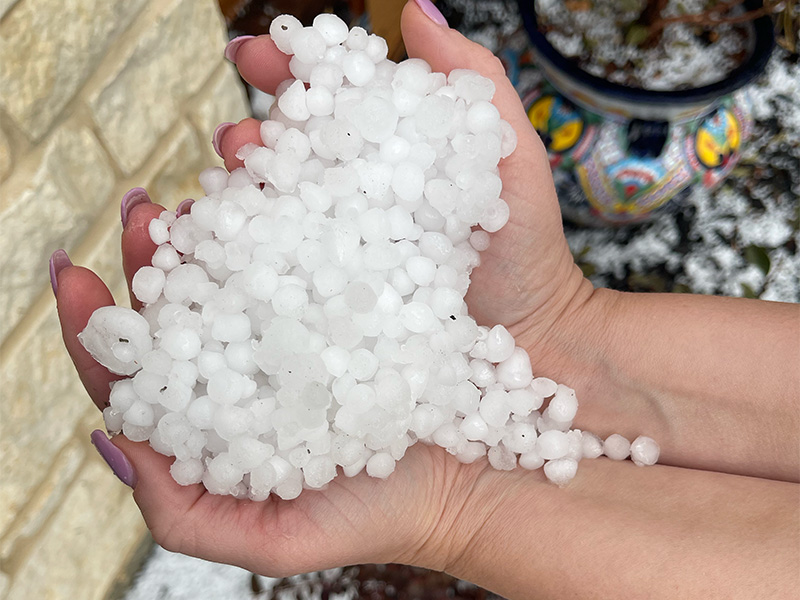
- Granule Loss: When hailstones are small, around the size of a pea (less than 1 inch in diameter), they can cause the granules on asphalt shingles to come loose. You’ll notice an accumulation of these granules in your gutters and downspouts.
- Minor Dents: Small hail might not break the shingles but can leave minor dents and cause bruising, which weakens the shingle over time.
Hailstones 1-2 inches (2.5-5 cm) in diameter:
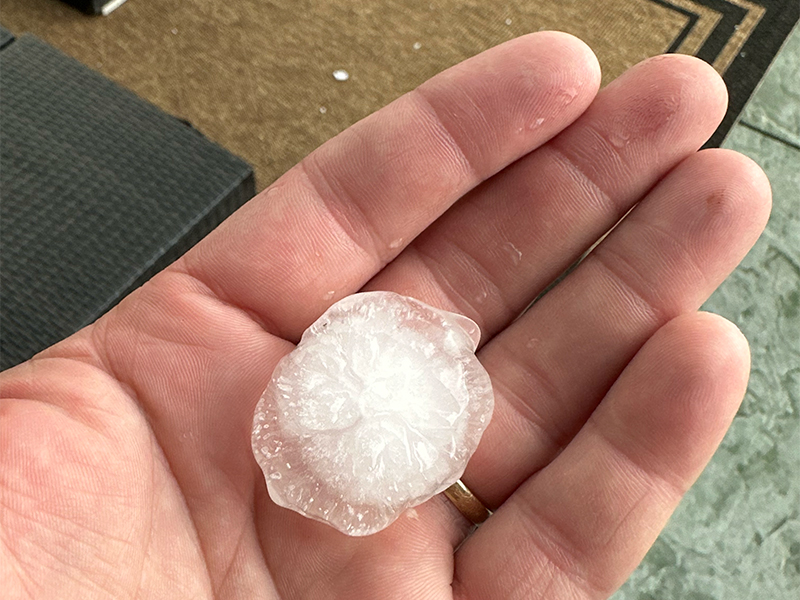
- Shingle Damage: Hailstones this size, comparable to a quarter or a golf ball, can crack or puncture shingles. Look for splits, tears, or holes in your shingles.
- Exposed Underlayment: The impact can expose the underlayment, the protective layer beneath the shingles, making your roof vulnerable to leaks.
Hailstones larger than 2 inches (5 cm) in diameter:
- Severe Shingle Damage: Large hailstones, like those the size of a baseball, can cause significant damage. Shingles may be broken or shattered.
- Dented Metal Components: Check metal flashing, vents, and gutters for deep dents or dings. These large hailstones can deform and damage these components significantly.
- Structural Damage: Large hailstones can compromise the integrity of the roof’s structure. You might find soft spots or spongy areas if the decking beneath the shingles is damaged.
If you suspect hail damage, schedule a thorough roof inspection with a licensed roofing contractor to ensure your home remains safe and secure. Ignoring hail damage can lead to leaks, mold growth, and structural issues, resulting in costly repairs.
How To Inspect Your Roof for Hail Damage From the Ground
After a hailstorm, start by examining your property from the ground. Walk around your home and take note of any visible changes. This initial inspection can reveal significant damage indicators without the need to climb onto the roof. Focus on areas where hail damage is most likely to occur. Look for debris, displaced materials, and any other signs of impact. Here are the key signs to look for:
Shingles on the Ground
After a hailstorm, look for pieces of shingles around your property. High winds often accompany hail, causing shingles to blow off. Finding them on the ground suggests possible damage to your roof.
Granules in Your Gutters
Check your gutters for an excessive amount of shingle granules. Hail impacts can dislodge these granules, leading to their accumulation in your gutters. This is a strong sign of hail damage.
Dented or Splattered Metal Panels
Check metal surfaces like electrical panels for dents or splatter marks. These marks indicate the size and direction of the hailstones, helping assess the storm’s impact.
Dented Wall Vents
Examine wall vents for dents. Soft metal vents are prone to denting from hailstones, which can also imply potential damage to your roof.
Painted Wood Surfaces with Damage
Look at painted wood surfaces around your building. Hail can leave dimples or chip the paint, exposing the wood underneath. Fresh damage is a clear sign of a recent storm.
Broken Landscape Lights
Check your landscape lights for any cracks or breaks. Hail can cause significant damage to these fixtures, indicating the intensity of the storm.
Tree Debris
Look for broken branches and fallen leaves on the ground. Heavy winds that accompany hailstorms can break tree limbs, signaling the storm’s strength and potential damage.
Remember, hail damage can be subtle, and some signs may not be immediately apparent. If you suspect damage, schedule an inspection with a professional roofing contractor to take a closer look. A professional roofing contractor can spot potential problems and recommend the right fixes to keep your roof secure and durable.
Can Hail Damage to a Roof Be Repaired?
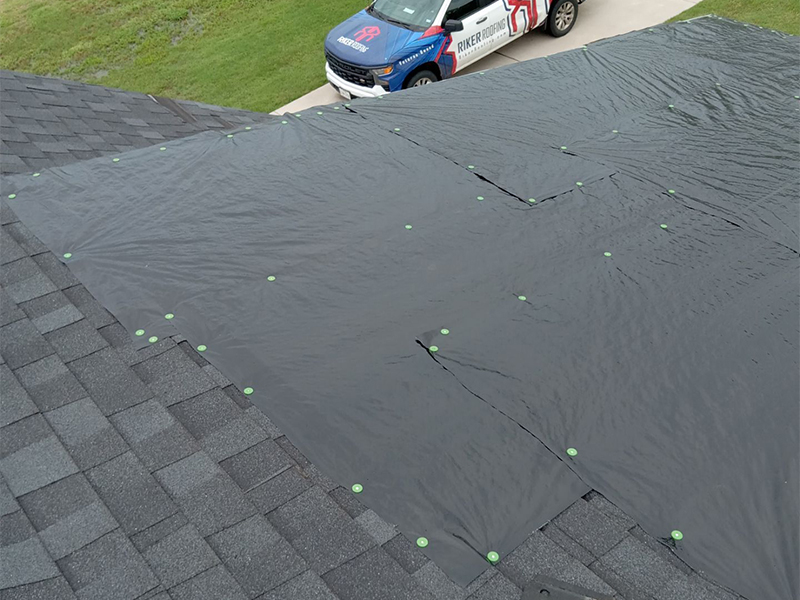
Yes, hail damage to a roof can be repaired, but the extent of the repair work needed varies widely depending on the severity of the damage. In some cases, hail damage might only require minor fixes, like replacing a few damaged shingles or patching small holes. But in more severe cases, the damage can be more extensive, requiring repairs to multiple layers of the roof or even a full roof replacement.
Some common repairs for hail damage include:
- Replacing damaged or missing shingles
- Repairing cracks and holes in the roof surface
- Replacing damaged flashing and vents
- Repairing or replacing damaged gutters and downspouts
A roofing professional can assess the damage and recommend the necessary repairs to help return your roof to a safe and secure condition.
What Happens If You Ignore Hail Damage On Your Roof?
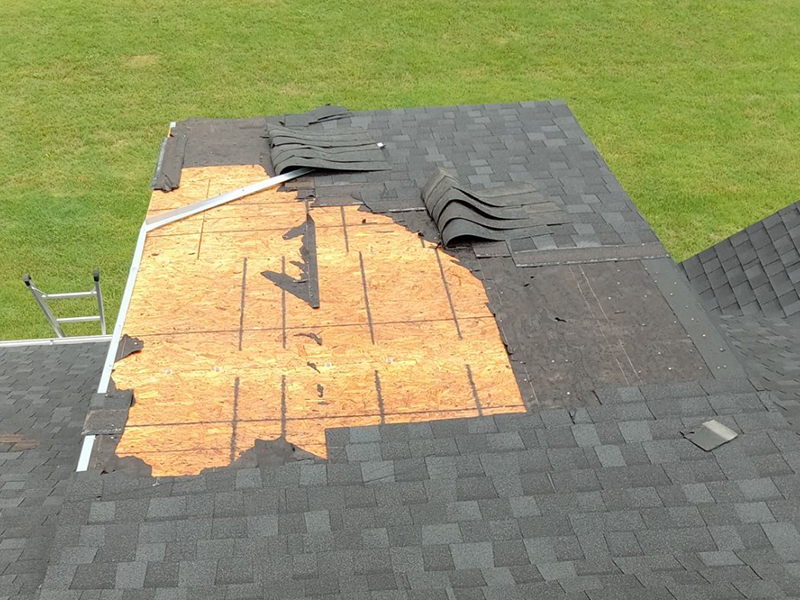
If you suspect your roof has been damaged by hail, it’s a good idea to get on top of it right away. Ignoring hail damage can lead to a range of issues that can compromise your home’s integrity and put your family’s safety at risk. We’ve seen it happen time and time again – small problems turn into big ones, and what could have been a simple fix turns into a major overhaul.
Unchecked hail damage can create a whole host of issues that can snowball fast and wreak havoc on your home’s structure and interior. Here are some of the most common consequences of putting off hail damage repairs:
Leaks and Water Damages
Hail can create small cracks and holes in your roofing materials. These openings let water seep in, causing leaks. If ignored, these leaks lead to severe water damage, rotting, and decay in your roof’s structure, including the decking, rafters, and trusses. Over time, water can spread, damaging insulation, drywall, and electrical systems. Ignoring hail damage can result in:
- Water spots on ceilings and walls
- Warped or buckled flooring
- Damaged insulation and drywall
- Disrupted electrical and HVAC systems
Structural Damage
Hail damage can compromise the structural integrity of your roof. When hail hits with enough force, they can cause significant damage to shingles, underlayment, and decking. Overtime, this damage can compromise the roof’s ability to protect your home. Ignored hail damage may lead to:
- Cracked or broken shingles
- Sagging or collapsed rooflines
- Cracked or broken rafters and trusses
- Weakened roof decking
- Damaged underlayment
Mold and Mildew Growth
When hail damage allows water to seep into your roof, this creates the perfect environment for mold and mildew to grow. These fungi thrive in damp conditions and can cause serious issues including:
- Moldy insulation
- Mildew-stained walls and ceilings
- Musty odors throughout your home
- Health issues like allergies and respiratory problems
Higher Repair Costs Later
Delaying repairs for hail damage can lead to much higher costs down the line. What starts as a small, manageable issue can quickly become a major problem. Small cracks or leaks can turn into significant structural problems, requiring extensive repairs or even a full roof replacement. By addressing damage promptly, you can avoid:
- Costly emergency repairs
- More extensive interior repairs
- Increased material and labor costs
- Potential for additional damage to other home systems and components
When to Call a Roofing Company
Hail damage can be sneaky, and it’s not always easy to spot. But if you notice any of the signs we’ve discussed, it’s time to call in the professionals. Don’t wait until the damage becomes a catastrophe – a small leak today can become a major headache tomorrow. When you suspect hail damage, it’s crucial to act fast and get a roofing company on the scene ASAP.
Here’s the thing: a good roofing company can be the difference between a quick fix and a total roof replacement. They’ll assess the damage, identify the source of the problem, and get to work on repairs or replacement. And, if you’re lucky, they might even help you navigate the insurance claims process.
So, don’t hesitate – if you suspect hail damage, pick up the phone and call a trusted roofing company today. Your roof (and your wallet) will thank you.
Protect Your Plano Home from Hail Damage
As a homeowner in Plano, TX, you know that hail storms can strike at any moment. Now that you know the signs of hail damage and the importance of acting fast, it’s time to take control of your roof’s integrity. At Riker Home Services, we’re dedicated to providing professional roofing services that will give you peace of mind and protect your home from the elements.
Don’t let hail damage catch you off guard—schedule a roof inspection with our experts today and ensure your home is secure for years to come. With our comprehensive services, you can trust that your roof is in good hands.
Call us at (469) 551-3473 or fill out our online form to take the first step towards a secure roof today!
